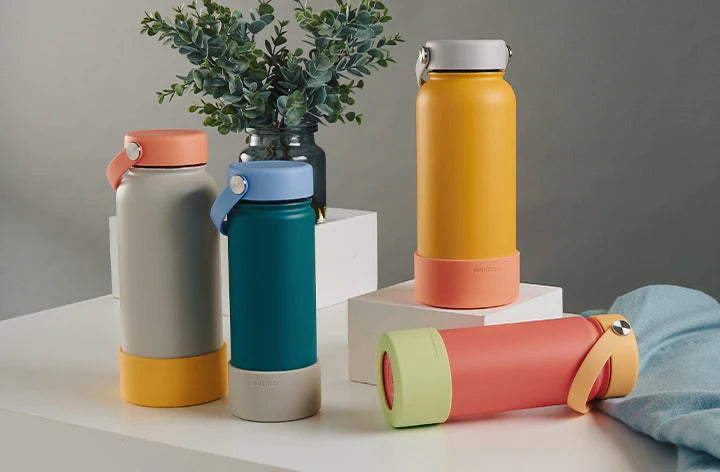From Elegant Glass Bottles To Chic Reusable Stainless Steel Water Bottles, Which Are The Best Types Of Water Bottles For Your Lifestyle?
We’ve come a long way from the days of drinking out of reused plastic water bottles (anyone remember the Seamaster plastic bottles from schooling days?).
Now we’re spoilt with countless different choices of water bottles at only a few clicks away. Think reusable plastic water bottles that totally differ from the flimsy reused ones, beautifully designed thermoregulated stainless steel water bottles like those from Montigo, or elegant glass water bottles that are found in many minimalist homes these days.

But here’s the thing, you don’t want just any water bottle. Because the less you feel for it, the more likely you’re going to avoid drinking from it. People simply don’t use things they don’t like and that’s the painful truth of it all.
So where do you even begin to find the right one that suits your lifestyle - which you’ll actually like?
I’ll go first. It starts by knowing exactly what types of water bottles are available out there, along with how it could potentially be the perfect match to your lifestyle.
And that’s why you’re here today, because we’re compiled a list of all the types of water bottles you can find in Malaysia along with how each of them work, so you can make an informed choice while shopping for your next perfect hydration companion. Goodbye dehydration!
7 Types Of Water Bottles In Malaysia: Advantages & Disadvantages Of Each Water Bottle Material

1. Plastic Water Bottles
There’s a reason why plastic water bottles are the most common types of water bottles in Southeast Asia. They are lightweight, often reusable, and sometimes highly durable.
Plastic water bottles are typically made from plastic compounds such as PET (polyethylene terephthalate), PP (polypropylene), and HDPE (high-density polyethylene) to name a few. Which brings us to how there are two types of plastic water bottles to take note of; disposable plastic water bottles, and reusable plastic water bottles.

Disposable plastic water bottles are one that we are all too familiar with as Malaysians. Most of us refer to it as the “mineral water plastic bottle” since it’s often seen as the bottle that holds mineral water in supermarkets. But since we’re focused on hydration companions - disposable ones are out of the question by default. (You shouldn’t reuse them either because plastic particles will leach into your drink with each use.)
Which brings us to reusable plastic water bottles. These are one of the most versatile water bottles around because it is durable and lightweight, making it one of the most convenient water bottles to be carried around, be it for gym, work, school, or outdoor activities such as picnics, hiking, and walks.
Plastic water bottles are also porous, causing them to absorb flavours easily. This means that your plain water will likely smell and taste like Milo if you’ve stored that chocolate malt drink inside beforehand - yes, even after you’ve washed the bottle!
Advantages of Plastic Water Bottles:
-
Lightweight, highly portable.
-
Resistant to minor drops and impact.
-
Typically more affordable.
-
Available in various shapes, sizes, styles, and colours.
-
Transparent options are available to easily spot contaminants.
Disadvantages of Plastic Water Bottles:
-
High carbon footprint if not recycled properly.
-
Low-quality plastic bottles may leach harmful chemicals
-
Unsuitable for use once exposed to hot liquid
-
Easily absorbs and releases flavours and odours.
-
Prone to scratches and abrasions while washing.

2. Single-Wall Stainless Steel Water Bottles
Not all stainless steel water bottles are made alike other than the fact that it is made from stainless steel, a combination of iron-based alloys that boast incredible durability and high resistance against rust and corrosion.
You have single-walled stainless steel water bottles which are made from one layer of stainless steel, and then you have thermoregulated stainless steel water bottles which consist of a vacuum insulated space between multiple stainless steel layers.
The focus here is on single-wall stainless steel water bottles, a versatile water bottle that is ideal for high impact outdoor activities like camping, biking, hiking, and trekking. That’s because they are incredibly durable and generally BPA-free, making it a versatile AND healthy choice out of the many types of water bottles out there.
But while single-wall stainless steel water bottles offer various advantages, they do have their disadvantages as well. For instance, single-wall stainless steel water bottles are often heavier than plastic bottles, and they are prone to condensation which makes it slippery to drip.
Individuals with wooden furniture at home will not appreciate the condensation that happens as it can lead to stains which will ruin the wooden furniture’s beautiful surface. And not forgetting how sensitive individuals can detect hints of metallic taste from low-quality single-wall stainless steel bottles, leading to an off-putting experience.
Advantages of Single-Wall Stainless Steel Water Bottles:
-
Highly durable against impact.
-
Resistant to rust and corrosion.
-
BPA-free and non-toxic.
-
Easily recyclable.
-
Easy to clean.
-
Available in various designs, shapes, and colours.
Disadvantages of Single-Wall Stainless Steel Water Bottles:
-
Heavier than plastic water bottles.
-
Tends to be expensive.
-
Tough to spot contaminants.
-
Prone to condensation, leading to a slippery grip.
-
Prone to leaching metallic flavour and scent.
-
Vulnerable to dents and scratches.

3. Thermoregulated Stainless Steel Water Bottles
Thermoregulated stainless steel water bottles are sometimes also known as vacuum insulated water bottles, or double-wall insulated bottles. But some of you may be more familiar with the term “thermos” as it was more common to refer to it as such growing up.
Even so, all these names point to the very same thing - a stainless steel water bottle made with two (sometimes three) layers of stainless steel, with a vacuum-sealed space between the walls.
This design makes thermoregulated stainless steel water bottles incredibly durable, while also keeping your drink at the perfect temperature for hours. We’re talking for up to 24 hours. Amazing, right?

Thermoregulated stainless steel water bottles like Montigo’s stunning range of thermoregulated hydration buddies are great for high impact activities like hiking, cycling, camping, trekking, and various outdoor activities, to low impact ones like daily commutes, work, school, gym, yoga, and home use.
It’s one of the best ways to keep your comforting soups hot for rainy days in the office, or refreshing iced water cold all day without condensation. Which means you can stay comfortably hydrated and refreshed even while you’re on-the-go with a thermoregulated stainless steel reusable bottle!
The only downsides to thermoregulated stainless steel water bottles are how they tend to be a little heavier than plastic water bottles, glass bottles, and single-wall stainless steel water bottles. They are also usually at a premium compared to other water bottles, but with the benefits and for how long they last, I’d say it’s worth every ringgit spent.
Advantages of Thermoregulated Stainless Steel Water Bottles:
-
Amazing temperature retention up to 24 hours - both hot and cold drinks.
-
Resistant to impact.
-
High resistance against rust and corrosion.
-
Food-grade stainless steel is non-toxic with no toxic chemicals.
-
Condensation-free.
-
Recyclable and reusable, making it eco-friendly.
-
Reduces your carbon footprint by reducing plastic waste.
-
Suitable for high and low impact activities indoors and outdoors.
-
Stores hot drinks safely without heat transfer.
-
Most thermoregulated stainless steel water bottles have a wide mouth to fit ice cubes easily.
Disadvantages of Thermoregulated Stainless Steel Water Bottles:
-
Heavier than glass, plastic, and single-wall stainless steel bottles.
-
Bulkier than other bottles of the same internal volume.
-
Challenging to spot contaminants due to its opaque form.
-
Vulnerable to dents on the outer wall.
-
Premium price compared to non-thermoregulated water bottles.

4. Glass Water Bottles
Glass bottles need little to no introduction due to their recent rise in popularity as one of the best eco-friendly water vessels, and their usual breathtaking aesthetic. It’s the preferred choice to store water as it is typically made organically. This means you won’t experience any changes in the taste and scent of the water contained.
Glass water bottles are commonly made from either pure glass, borosilicate glass (the most expensive and durable), or soda lime glass. But because they are delicate in nature, glass bottles are best for gentle environments and situations that don’t involve rough use or dynamic movements like offices, pilates and yoga studios, homes, and cafes.
If you’re a yoga or pilates practitioner or a desk jobber that generally bounces between the office, home, and studio, then glass water bottles would be one of the healthiest hydration buddies you can use. That’s because it is non-toxic, easy to clean, eco-friendly, and visually beautiful. Some glass bottles even come with a silicone sleeve to protect your bottle against impact.
Having said that, there are downsides to these stunning vessels. It’s incredibly fragile, so even the lightest impact could cause a chip or crack on the bottle, and if it chips on the inside - you may even have to look out for glass shards in the water! It’s also usually heavier than stainless steel water bottles due to its thickness, pricier, and not the most convenient one to hold out-and-about as it is prone to condensation on its surface when used to store cold water.
Fun Fact: Did you know that double-walled glass water bottles are also available? Double-walled glass water bottles are fantastic as they avoid the problem of condensation that normal glass bottles are prone to!
Advantages of a Glass Bottle:
-
Odour-free.
-
Non-porous so flavours will not be absorbed.
-
Easy to clean.
-
Easily recyclable, making it eco-friendly.
-
Aesthetically pleasing.
-
Easy to spot contaminants due to transparent nature.
Disadvantages of a Glass Bottle:
-
Tends to be heavier than certain stainless steel and plastic water bottles.
-
Prone to cracks, chips, and shatters once dropped or exposed to impact.
-
Pricier than stainless steel and plastic bottles.
-
Not suitable for outdoor use.
-
Prone to condensation, making it slippery to hold.
-
Some are not suitable for storing hot beverages.

5. Ceramic Water Bottles
When it comes to ceramic water bottles, most of us would probably think of clay bottles or jars. But these days, ceramic water bottles typically refer to ceramic-lined stainless steel water bottles.
These types of ceramic water bottles are often insulated as they feature double or triple-walled vacuum insulation with a ceramic-lined interior to prevent any possibility of metallic scents and flavours from leaching into the bottled contents.
While it all sounds fantastic, the downside is that these bottles are often heavier due to the extra layer compared to thermoregulated stainless steel water bottles. The fact that it is more expensive to manufacture and how it isn’t as indestructible as stainless steel water bottles also makes it somewhat rare to be found.
There is also the fact that individuals will need to carefully watch out for the materials used to make the ceramic water bottle, as some manufacturers use aluminium in place of stainless steel as a cheaper alternative. If that’s the case, then I highly would not recommend it as aluminium tends to be reactive once exposed to acidic beverages such as citrus juices and coffee.
Advantages of Ceramic Water Bottles:
-
Excellent temperature retention to keep drinks hot or cold for hours.
-
Non-reactive to acidic beverages.
-
Non-toxic, while the ceramic layer is intact.
-
Typically comes in muted-minimalist designs and colours.
-
Suitable for storing various beverages such as coffee and citrus juices.
Disadvantages of Ceramic Water Bottles:
-
Expensive.
-
Inner ceramic lining is prone to cracks and chips once exposed to impact or abrasive cleaning tools.
-
Heavier than thermoregulated stainless steel bottles.
-
Not suitable for rough and dynamic activities and environments.
-
Challenging to discover chips and cracks on its interior.
-
Cheaper ceramic water bottles may be made with aluminium instead of stainless steel for its outer walls, making it prone to reactivity when exposed to acidic beverages like coffee and citrus juices.
6. Silicone Water Bottles
You may have seen silicone bottles in the form of reusable collapsible coffee cups, but did you know these also come in the form of bottles, also known as silicone water bottles?
Silicone water bottles may not be as widely known as the rest of the water bottles we’ve listed here, but it definitely does have its advantages. For starters, silicone water bottles are typically flexible and collapsible, making it one of the best when it comes to travelling light where space and weight is of concern.
Good silicone water bottles are also made from food-grade silicone, making it suitable for storing hot liquids safely. And the best part? They are incredibly durable as its soft nature makes it indestructible against drops and impact.
Water bottles made from silicone are often sold by outdoor gear retailers and certain drinkware manufacturers with a focus towards the coffee industry as a type of specialty drinkware. And remember how we spoke of its durability? That very same characteristic makes it one of the most popular water bottles for outdoor activities such as hiking, trekking, mountaineering, camping, marathons, and even daily commutes.
Advantages of Silicone Water Bottles:
-
Collapsible and flexible characteristics make it a great space-saver.
-
Incredibly portable due to lightweight nature.
-
Resistant to impact.
-
Made from food-grade silicone, making it heat-safe and non-toxic.
-
Typically dishwasher safe.
-
Easy to clean.
-
Comes in vibrant colours and various shapes.
Disadvantages of Silicone Water Bottles:
-
No temperature regulation nor retention.
-
Prone to smell if not cleaned or air-dried properly.
-
Sensitive individuals may experience the undesirable odd silicone scent or taste.
-
It may lose its shape and stability over time.
-
Usually comes with a premium price tag.
-
Very limited capacity because of its smaller build.

7. Aluminium Water Bottles
Thinner and lighter, but often the less popular choice when it comes to metal bottles, enter the realm of the aluminium water bottle. This type of water bottle is made from aluminium with an inner lining to prevent any reactivity to acidic drinks like citrus juices and coffee.
The lightweight nature of aluminium makes it a favourite hydration buddy for outdoor enthusiasts who enjoy hiking, mountaineering, bouldering, biking, and jungle trekking, to name a few. It makes it easy to carry while bearing a decent level of durability, which is what makes it ideal for the great outdoors.
Having said that, an aluminium water bottle is very often a less popular option to outdoor enthusiasts compared to a stainless steel water bottle because of its non-insulating characteristics.
Aluminum water bottles also tend to be softer and more prone to dents compared to stainless steel. And once the inner lining degrades over natural wear and tear it becomes reactive to drinks like hot coffee and tea, which are often enjoyed by outdoor adventurers.
Advantages of Aluminium Water Bottles:
-
Lightweight, almost as light as a plastic water bottle.
-
Semi-durable against impact.
-
More affordable than a stainless steel water bottle.
-
The most eco-friendly metal water bottle to recycle.
-
Comes in various bright colours and sizes.
Disadvantages of Aluminium Water Bottles:
-
Typically robust design makes it a less popular choice for those who prioritise aesthetics.
-
Potentially reactive if the inner lining is damaged through wear and tear.
-
Prone to dents.
-
A low quality aluminium water bottle is toxic due to chemical leaching.
-
Little to no temperature retention.
Frequently Asked Questions On The Types Of Water Bottles In Malaysia
Which type of bottle is best for drinking water?
When it comes to the best types of water bottles for drinking water, I’d highly recommend sticking to the basics of a BPA-free water bottle, glass bottle, single-walled stainless steel water bottle, and stainless steel vacuum insulated water bottle.
Reason being that they are non-reactive so they won’t leach chemicals or undesirable scents and flavours into pure drinking water. Not forgetting how they are typically more aesthetically pleasing so that you’ll actually enjoy using it to stay hydrated!
Bonus Tip: Pop a straw lid like the Montigo Ace Straw Cap on your water bottle to make your drinking experience that much better!
Extra Tip: Make sure to use a non-abrasive bottle brush to clean your BPA-free plastic water bottle to prevent scratches on its inner lining. This keeps your BPA-free plastic water bottle as tox-free as it can be for the years to come!
What are the different types of reusable water bottles?
While all seven types of water bottles are reusable, the absolute best reusable water bottles are definitely the glass bottle, stainless steel water bottle, and vacuum insulated stainless steel water bottle.
A glass reusable water bottle is made from organic materials, making it chemical-free and naturally non-toxic. So the only time you’ll have to worry is when it cracks or chips. Whereas stainless steel water bottles are naturally hypoallergenic and incredibly durable so you won’t have to fear any possibility of chemicals leaching even if it is dented.










